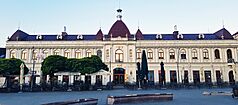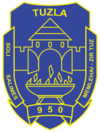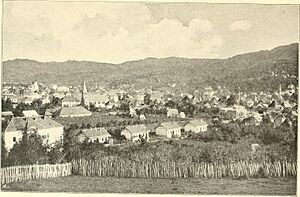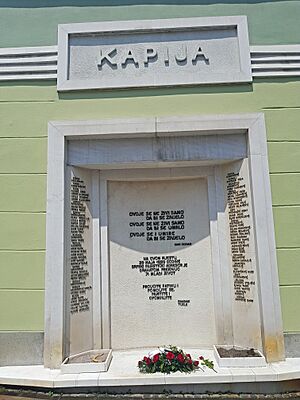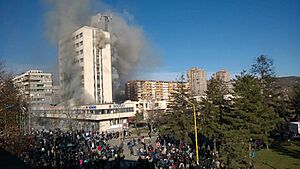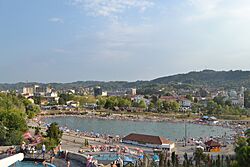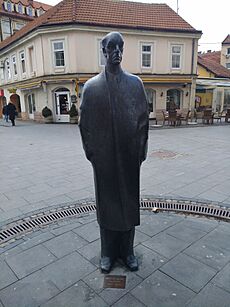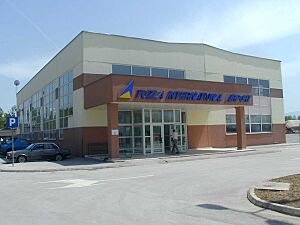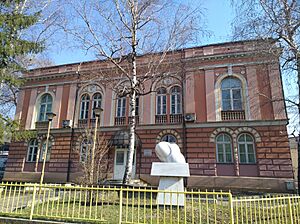Tuzla facts for kids
Quick facts for kids
Tuzla
Tyзла
|
|||
|---|---|---|---|
| Grad Tuzla Град Тузла City of Tuzla |
|||
|
Tuzla panorama
Pannonian Lakes
Trg Slobode
Tuzla Thermal Power Plant
Residential Zone Stupine
Salines Soli Building
|
|||
|
|||
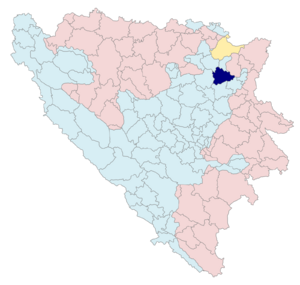
Location of Tuzla within Bosnia and Herzegovina (dark blue)
|
|||
| Country | |||
| Entity | Federation of Bosnia and Herzegovina | ||
| Canton | |||
| Area | |||
| • City | 294 km2 (114 sq mi) | ||
| Elevation | 245 m (804 ft) | ||
| Population
(2018)
|
|||
| • City | 110,979 | ||
| • Density | 377.5/km2 (978/sq mi) | ||
| • Urban | 80,570 | ||
| Time zone | UTC+1 (CET) | ||
| • Summer (DST) | UTC+2 (CEST) | ||
| Postal code |
75000
|
||
| Area code(s) | +387 35 | ||
Tuzla is the third-largest city in Bosnia and Herzegovina. It is the main city of the Tuzla Canton in the Federation of Bosnia and Herzegovina. In 2013, about 110,979 people lived there.
Tuzla is a very important city for the economy, culture, education, and tourism in northeast Bosnia. It has two universities, making it a big learning center. It's also a major industrial hub and a strong economic area, with many different industries and a growing service sector. This growth is partly thanks to its unique salt lake, which attracts many tourists.
The city of Tuzla is special because it has Europe's only salt lake right in its central park. More than 350,000 people visit the lake every year. The city's history goes back to the 9th century. Modern Tuzla started around 1510 when it became an important military town in the Ottoman Empire.
Tuzla is known as one of the most multicultural cities in Bosnia and Herzegovina. It has kept its diverse character, even through the Bosnian War and after. People from different groups like Bosniaks, Serbs, Croats, and a small number of Bosnian Jews live together in Tuzla.
Contents
- What Does the Name Tuzla Mean?
- Tuzla's Rich History
- Tuzla's Geography and Unique Salt Deposits
- Tuzla's Climate
- How Tuzla is Governed
- People of Tuzla: Demographics
- Tuzla's Culture and Traditions
- Transportation in Tuzla
- Tuzla's Economy
- Education in Tuzla
- Famous People from Tuzla
- Tuzla's International Connections
- Images for kids
- See also
What Does the Name Tuzla Mean?
The name Tuzla comes from the Ottoman Turkish word tuzla, which means "salt mine". This name refers to the huge salt deposits found deep under the city. In the past, this salt was mined and sold, bringing a lot of money to the Ottoman Empire. Because they share the same name, Tuzla is a sister city with Tuzla, a suburb of Istanbul, Turkey.
Tuzla's Rich History
Ancient Times and Early Settlements
Archaeologists have found signs that Tuzla was a busy settlement during the Neolithic period, which was a very long time ago. People have lived here continuously for over 6,000 years, making Tuzla one of the oldest places in Europe where people have always lived. Before the Romans took over the area, Tuzla (then called Salines) was ruled by the Illyrian tribe called Breuci.
From Middle Ages to the 20th Century
The city was first mentioned in the year 950 by Constantine Porphyrogenitus. He called it a fort named Salines. In the Middle Ages, it was known as Soli, which means "salts" in Bosnian. The city's current name, Tuzla, means "place of salt" in Ottoman Turkish.
During the Middle Ages, Tuzla was mostly part of the medieval Kingdom of Bosnia. After the kingdom fell to the Ottoman Empire in 1463, the Ottomans took control of the area around 1512. Tuzla remained under Ottoman rule for almost 400 years.
In 1878, Austria-Hungary took control of Tuzla. After this empire ended, Tuzla became part of the new Kingdom of Yugoslavia. During World War II, Tuzla was freed from German control by Yugoslav Partisans on October 2, 1943. This made it one of the first places in Europe to be liberated. After the war, Tuzla grew into a major industrial and cultural center in Yugoslavia.
The Bosnian War and Its Impact
During the Bosnian War (1992-1995), Tuzla was unique because it was the only city not controlled by the main nationalist party. After Bosnia and Herzegovina became independent, Serbian forces surrounded the city.
One sad event during the war was on May 25, 1995. Shells fired from Serb positions hit the central street, killing 71 people and injuring 200. The youngest person who died was only two years old. This event is known as the Tuzla massacre. After the war, Tuzla became the headquarters for U.S. forces helping to keep the peace.
Tuzla After the War
In February 2014, Tuzla was where protests started that spread across Bosnia and Herzegovina. People were upset and eventually burned cars and the local government building. In recent years, Tuzla has seen its economy grow, and more tourists are visiting the city.
Tuzla's Geography and Unique Salt Deposits
Tuzla is in the northeastern part of Bosnia, nestled below the Majevica mountain range, along the Jala River. The main part of the city is on a flat area, while homes are built on hills to the north and south. The city is about 237 meters (778 feet) above sea level. Tuzla has a moderate continental climate.
The area around Tuzla has a lot of coal. Six coal mines are still working near the city. Much of this coal is used to power the Tuzla Thermal Power Plant, which is the biggest power plant in Bosnia and Herzegovina.
Salt Deposits and Sinking Ground
For a long time, especially in the 20th century, removing salt from under the city caused parts of the city center to sink. Buildings in these "sinking areas" either fell down or had to be taken down. This is why there are not many old buildings in Tuzla that are from before the 20th century, even though the city is over 1000 years old. There's an area in the northeast called Solina, named after the salt deposits.
The Pannonian Lakes: Europe's Only Salt Lakes
Tuzla is the only city in Europe with a salt lake right in its center. Millions of years ago, a huge sea called the Pannonian Sea covered this area. It dried up about 10 million years ago. But thanks to scientists, salty water can now be kept stable at the surface. In 2003, the first Pannonian Lake opened.
A second lake with artificial waterfalls opened in 2008. An archaeological park and copies of ancient lake homes were also built, showing visitors about the different cultures that lived here long ago. This spot has become a popular place for tourists from all over the world.
A third lake was finished in August 2012. It also has two water slides, which are a big hit with younger visitors. In the summer of 2013, about 5,000 people visited the lakes every day, with a total of about 450,000 visitors over three months.
Tuzla's Climate
Tuzla has a moderate oceanic climate with warm summers. The temperature often goes above 25°C (77°F), and sometimes above 30°C (86°F). Winters are cold, with temperatures often below 0°C (32°F). Thunderstorms and hail are more common in spring and summer. The highest temperature ever recorded in Tuzla was 40.7°C (105.3°F) on July 22, 2007.
| Climate data for Tuzla (1991-2020, extremes 1961-2020) | |||||||||||||
|---|---|---|---|---|---|---|---|---|---|---|---|---|---|
| Month | Jan | Feb | Mar | Apr | May | Jun | Jul | Aug | Sep | Oct | Nov | Dec | Year |
| Record high °C (°F) | 21.0 (69.8) |
25.3 (77.5) |
30.0 (86.0) |
33.0 (91.4) |
34.2 (93.6) |
37.2 (99.0) |
40.7 (105.3) |
40.5 (104.9) |
38.2 (100.8) |
31.0 (87.8) |
26.6 (79.9) |
21.6 (70.9) |
40.7 (105.3) |
| Mean maximum °C (°F) | 12.7 (54.9) |
14.0 (57.2) |
17.7 (63.9) |
23.5 (74.3) |
26.2 (79.2) |
30.4 (86.7) |
31.8 (89.2) |
33.1 (91.6) |
28.6 (83.5) |
22.7 (72.9) |
17.9 (64.2) |
9.7 (49.5) |
33.1 (91.6) |
| Mean daily maximum °C (°F) | 5.5 (41.9) |
8.2 (46.8) |
13.1 (55.6) |
18.2 (64.8) |
22.6 (72.7) |
26.1 (79.0) |
28.3 (82.9) |
28.8 (83.8) |
23.5 (74.3) |
18.7 (65.7) |
12.5 (54.5) |
6.0 (42.8) |
17.6 (63.7) |
| Daily mean °C (°F) | 0.5 (32.9) |
2.4 (36.3) |
6.3 (43.3) |
11.0 (51.8) |
15.3 (59.5) |
18.8 (65.8) |
20.9 (69.6) |
20.5 (68.9) |
15.7 (60.3) |
11.1 (52.0) |
6.1 (43.0) |
1.3 (34.3) |
10.8 (51.5) |
| Mean daily minimum °C (°F) | −3.0 (26.6) |
−2.1 (28.2) |
1.3 (34.3) |
5.2 (41.4) |
9.4 (48.9) |
13.2 (55.8) |
14.5 (58.1) |
14.4 (57.9) |
10.3 (50.5) |
6.3 (43.3) |
2.5 (36.5) |
−1.8 (28.8) |
5.9 (42.5) |
| Mean minimum °C (°F) | −9.8 (14.4) |
−8.0 (17.6) |
−2.5 (27.5) |
−0.3 (31.5) |
7.1 (44.8) |
10.7 (51.3) |
12.4 (54.3) |
12.4 (54.3) |
8.1 (46.6) |
2.7 (36.9) |
−1.5 (29.3) |
−6.4 (20.5) |
−9.8 (14.4) |
| Record low °C (°F) | −25.8 (−14.4) |
−22.0 (−7.6) |
−17.9 (−0.2) |
−6.6 (20.1) |
−1.1 (30.0) |
4.0 (39.2) |
6.0 (42.8) |
5.3 (41.5) |
−1.0 (30.2) |
−8.0 (17.6) |
−13.0 (8.6) |
−19.0 (−2.2) |
−25.8 (−14.4) |
| Average precipitation mm (inches) | 58.1 (2.29) |
53.5 (2.11) |
59.4 (2.34) |
71.9 (2.83) |
101.9 (4.01) |
115.4 (4.54) |
95.6 (3.76) |
69.8 (2.75) |
76.6 (3.02) |
78.6 (3.09) |
70.4 (2.77) |
68.3 (2.69) |
919.5 (36.2) |
| Average precipitation days (≥ 1.0 mm) | 9.4 | 9.3 | 8.6 | 9.8 | 11.1 | 11.1 | 8.9 | 6.8 | 7.9 | 8.5 | 8.3 | 9.8 | 109.5 |
| Average relative humidity (%) | 80.9 | 75.9 | 68.6 | 67.9 | 71.6 | 71.9 | 70.7 | 70.9 | 75.6 | 78 | 79.3 | 82.8 | 74.5 |
| Average afternoon relative humidity (%) | 73 | 65 | 54 | 56 | 56 | 57 | 56 | 55 | 58 | 63 | 68 | 76 | 61 |
| Mean monthly sunshine hours | 71.9 | 96.3 | 147.3 | 176.1 | 215.9 | 231 | 261.9 | 258.3 | 182 | 148.4 | 88.9 | 62.7 | 1,940.7 |
| Source 1: NOAA NCEI | |||||||||||||
| Source 2: Deutscher Wetterdienst (extremes 1961–2015, afternoon humidity at 14:00, 1973–1993) | |||||||||||||
How Tuzla is Governed
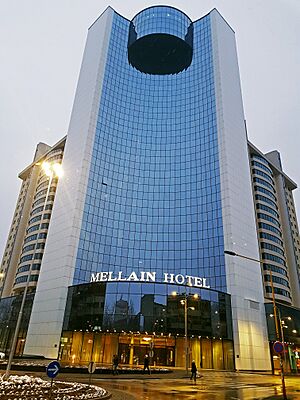
Tuzla is the main city of the Tuzla Canton, which is a part of the Federation of Bosnia and Herzegovina. It is also the center of Tuzla Municipality, one of 13 municipalities in the Tuzla Canton. Tuzla is divided into 39 local districts.
The current mayor of Tuzla is Zijad Lugavić from the Social Democratic Party (SDP BiH). He became mayor in 2022. The City Council of Tuzla has 30 members from different political parties.
People of Tuzla: Demographics
The population of Tuzla municipality has changed over the years. Here's a look at the different groups of people living there, based on past censuses:
1971 Census Data
Total population: 107,293
- 53,271 (49.65%) – Bosniaks (a South Slavic ethnic group, mainly Muslim)
- 27,735 (25.84%) – Croats (a South Slavic ethnic group, mainly Catholic)
- 21,089 (19.65%) – Serbs (a South Slavic ethnic group, mainly Orthodox Christian)
- 2,540 (2.36%) – Yugoslavs (people who identified with the former country of Yugoslavia)
- 2,658 (2.47%) – Other groups and unknown
1981 Census Data
Total population: 121,717
- 52,400 (43.05%) – Bosniaks
- 24,811 (20.38%) – Croats
- 20,261 (16.64%) – Serbs
- 19,059 (15.65%) – Yugoslavs
- 5,186 (4.26%) – Other groups and unknown
1991 Census Data
Total population: 131,618
- 62,669 (47.61%) – Bosniaks
- 21,995 (16.71%) – Yugoslavs
- 20,398 (15.49%) – Croats
- 20,271 (15.40%) – Serbs
- 6,285 (4.77%) – Other groups and unknown
2013 Census Data
Total population: 110,979
- 80,774 (72.78%) – Bosniaks
- 15,396 (13.87%) – Croats
- 3,378 (3.04%) – Serbs
- 11,431 (10.30%) – Other groups and unknown
Tuzla's Culture and Traditions
Arts and Literature
Meša Selimović, one of the most important writers in the Balkans, was from Tuzla. Every July, Tuzla hosts a book festival where the "Meša Selimović award" is given for the best novel written in the languages of Bosnia and Herzegovina, Croatia, Serbia, and Montenegro.
Tuzla has the oldest professional theater in Bosnia and Herzegovina, the Tuzla National Theatre, founded in 1898. The city also has several art galleries, like the Portrait Gallery and the Ismet Mujezinović Gallery, which show works by local and international artists. The Eastern Bosnia Museum displays historical and artistic items from the region. There's also an open-air museum at Solni Trg that tells the story of salt production in Tuzla.
Religious Sites in Tuzla
Tuzla has many mosques, and also an Orthodox church that was not damaged during the war. The Franciscan monastery of “St. Peter and Paul” is very active, as there is a good-sized Catholic community in Tuzla. A Catholic church outside the town, in the village of Breska, is 200 years old. Tuzla also has an old Jewish cemetery that was recently restored.
According to the 2013 census, most people in Tuzla (75.4%) are Muslims. About 13.7% are Catholics, and 3.3% are Orthodox Christians. Other religions make up 3.6%, and 3.9% of people are not religious.
Music of the Region
Bosnian roots music comes from areas like Middle Bosnia and the Drina valley. It's often played by singers with two violinists and a šargija player. This type of music became popular in the 1960s. It's thought to be one of the oldest forms of music in Bosnia, after sevdalinka and ilahija. This music is often passed down by ear from one generation to the next.
Sports in Tuzla
The Workers Sports Society Sloboda, founded in 1927, was the first sports organization in Tuzla. It has 14 different sports clubs. Tuzla is home to two football clubs, FK Sloboda and FK Tuzla City. Both teams play their home games at the Tušanj City Stadium.
The OKK Sloboda basketball club and RK Sloboda handball club play in the Mejdan Sports Arena, which can hold 4,900 people. The women's basketball team, Jedinstvo Aida, won the FIBA Women's European Champions Cup. One of the most famous sportswomen from Tuzla, Razija Mujanović, was part of this team and was later added to the FIBA Hall of Fame in 2017.
Fun Facts About Tuzla
- On September 1, 2007, 6,980 couples kissed for 10 seconds in Tuzla. This set a new Guinness World Record for synchronized kissing!
- Since September 26, 2008, Tuzla has offered free wireless internet access in its city center.
- On May 7, 2010, Tuzla tried to break the World Record for the largest mass waltz dance. Over 1,521 couples danced together in the main city square.
Transportation in Tuzla
Tuzla has an international airport called Dubrave (IATA code: TZL). The city also has a good public bus system. There are plans to add a trolleybus network soon.
The airport opened for civilian flights in 2008. In 2013, Wizz Air started using Tuzla International Airport as a base. Today, the airport connects Tuzla to more than 17 European cities and is still growing. In 2017, the airport had over 535,000 passengers, and in 2018, that number grew to over 584,000.
Tuzla also has a railway station with passenger services to Doboj. From Doboj, you can take trains to Sarajevo, Zagreb, and Belgrade. Bus and taxi services in Tuzla are well-organized and affordable. The main bus station was built in 1970 and was fully updated in 2017.
Tuzla's Economy
Tuzla is known for its Tuzla oil field.
Education in Tuzla
Tuzla is a big center for education. It is home to the University of Tuzla, which has 16,500 students. There are also other universities and academies like FINra University, Kallos University, IPI Academy, and Empirica faculty.
Universities in Tuzla
- University of Tuzla
Schools in Tuzla
- Association Citizens Educational Center
- Behram-Begova Medresa Tuzla
- Secondary Music School in Tuzla
- Gimnazija Meša Selimović
- Građevinsko-Geodetska Škola Tuzla (Construction and Geodesy School)
- Katolički Školski Centar "Sv.Franjo" Tuzla (Catholic School Center "St. Francis")
- Ekonomsko-Trgovinska Škola Tuzla (Economics and Trade School)
- Elektrotehnička Škola Tuzla (Electrical Engineering School)
- Medicinska Škola Tuzla (Medical School)
- Mješovita Mašinska-Saobraćajna Škola Tuzla (Mixed Mechanical and Traffic School)
Famous People from Tuzla
Many notable people come from Tuzla, including:
- Alma Zadić, an Austrian politician
- Amer Delić, a professional tennis player
- Andrea Petković, a German professional tennis player
- Andreja Pejić, an Australian model
- Damir Mulaomerović, a Croatian basketball player
- Denis Azabagić, a guitarist
- Emir Hadžihafizbegović, an actor
- Lepa Brena, a famous singer
- Maya Sar, a singer
- Meša Selimović, a renowned writer
- Mirza Delibašić, a basketball player who won Olympic, World, and European championships, and is in the FIBA Hall of Fame
- Miralem Pjanić, a footballer
- Miroslav Tadić, a musician
- Jusuf Nurkić, a basketball player for the Phoenix Suns
- Svetlana Dašić-Kitić, a retired handball player who was voted World Player of the Year in 1988
Tuzla's International Connections
Twin Towns and Sister Cities
Tuzla is twinned with these cities:
 Beşiktaş, Turkey
Beşiktaş, Turkey Bologna, Italy
Bologna, Italy L'Hospitalet de Llobregat, Spain
L'Hospitalet de Llobregat, Spain Linz, Austria
Linz, Austria Osijek, Croatia
Osijek, Croatia Pécs, Hungary
Pécs, Hungary Saint-Denis, France
Saint-Denis, France Tuzla, Turkey
Tuzla, Turkey
Partner Cities
 Novi Sad, Serbia
Novi Sad, Serbia
Images for kids
See also
 In Spanish: Tuzla para niños
In Spanish: Tuzla para niños







